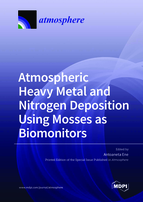Atmospheric Heavy Metal and Nitrogen Deposition Using Mosses as Biomonitors
A special issue of Atmosphere (ISSN 2073-4433). This special issue belongs to the section "Air Quality and Human Health".
Deadline for manuscript submissions: closed (31 October 2020) | Viewed by 17012
Special Issue Editor
Interests: nuclear and atomic analytical techniques; pollutants; nuclear radiations; environmental monitoring; biomonitoring
Special Issues, Collections and Topics in MDPI journals
Special Issue Information
Dear Colleagues,
Air pollution has a negative impact on various compartments of ecosystems, posing a threat to the natural environment and human health and causing significant economic damage. Due to their specific features, mosses are recognized as one of the main bioindicators and biomonitors of air contamination, with toxic elements including those originating from anthropogenic and natural sources. The determination of elemental concentrations in mosses is easier and cheaper than conventional precipitation analysis, and a much higher sampling density can be achieved by employing moss biomonitoring.
In recent decades, naturally growing mosses have been used successfully in biomonitoring campaigns for checking the atmospheric fallout of heavy metals and nitrogen (N) across Europe, and the approach has been extended in many regions of the world for characterizing multielemental deposition sources. Quantification of heavy metals and N in selected moss species provides a time-integrated measure of the spatial patterns and temporal trends of heavy metal deposition from the atmosphere to terrestrial ecosystems and a good indication of ecosystems at risk from high N deposition.
Manuscripts on all aspects of passive and active moss biomonitoring of air quality, heavy metals, and nitrogen pollution sources are welcome for this Special Issue.
Prof. Dr. Antoaneta Ene
Guest Editor
Manuscript Submission Information
Manuscripts should be submitted online at www.mdpi.com by registering and logging in to this website. Once you are registered, click here to go to the submission form. Manuscripts can be submitted until the deadline. All submissions that pass pre-check are peer-reviewed. Accepted papers will be published continuously in the journal (as soon as accepted) and will be listed together on the special issue website. Research articles, review articles as well as short communications are invited. For planned papers, a title and short abstract (about 100 words) can be sent to the Editorial Office for announcement on this website.
Submitted manuscripts should not have been published previously, nor be under consideration for publication elsewhere (except conference proceedings papers). All manuscripts are thoroughly refereed through a single-blind peer-review process. A guide for authors and other relevant information for submission of manuscripts is available on the Instructions for Authors page. Atmosphere is an international peer-reviewed open access monthly journal published by MDPI.
Please visit the Instructions for Authors page before submitting a manuscript. The Article Processing Charge (APC) for publication in this open access journal is 2400 CHF (Swiss Francs). Submitted papers should be well formatted and use good English. Authors may use MDPI's English editing service prior to publication or during author revisions.
Keywords
- mosses
- biomonitoring
- atmospheric deposition
- heavy metals
- nitrogen






